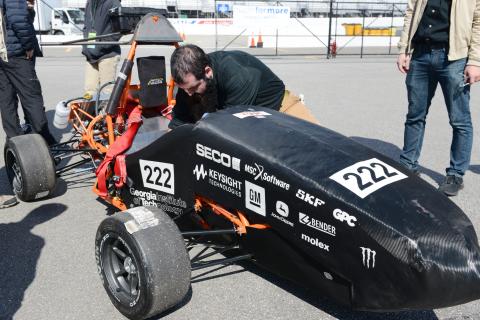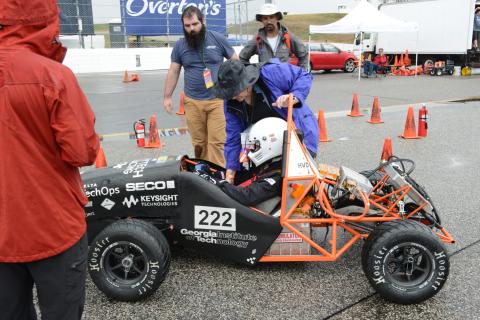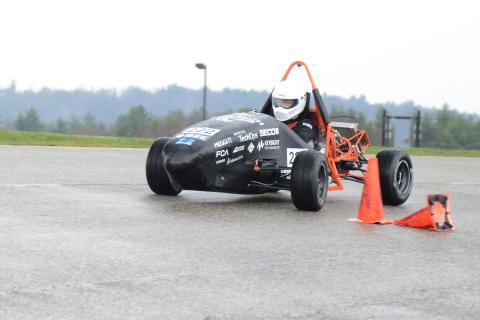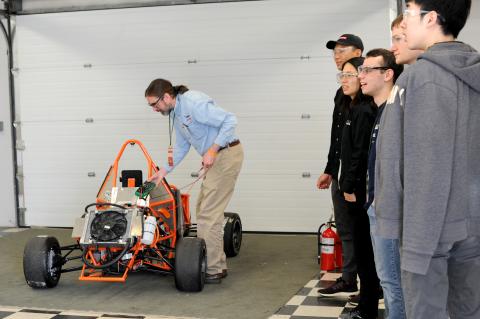Georgia Tech’s HyTech Racing team recently won first place at the Formula Hybrid competition.
Article written by Nathan Cheek, HyTech Racing Team President
Georgia Tech’s HyTech Racing team recently won first place at the Formula Hybrid competition. The competition took place April 30-May 3, 2018 at the New Hampshire Motor Speedway in Loudon, NH. HyTech’s electric vehicle drove 25 km in the endurance event in the rain, and was the fastest around the track, outpacing both electric and hybrid vehicles with a 60 second 1km lap time.
Formula Hybrid is a rigorous international student engineering competition where students design, manufacture, and test a formula-style single-seater racing vehicle. In order to successfully build a rules-compliant vehicle, students must become familiar with a wide array of engineering subjects, from suspension kinematics to high voltage battery pack designs.
Formula Student competitions such as Formula Hybrid place a special emphasis on design rather than simply performance. Hybrid employs a comprehensive ruleset and a rigorous scrutineering process, where students interact with engineers in industry and defend their design strategies and methodologies.
On top of winning the endurance event at Hybrid, HyTech also placed first in the design presentation and project management events. The team was also presented with the “Best Engineered Propulsion System Award” from General Motors, due to their compact pouch cell battery pack design.
In order to completely design an electric vehicle, a diverse interdisciplinary group of students is required. HyTech Racing accepts undergraduate and graduate students from all majors, of which currently 10 are from the School of Electrical and Computer Engineering at Georgia Tech. Many of these students choose to augment their electrical and computer engineering class experience by working on HyTech’s electrical subteam.
HyTech Racing’s electrical subteam works on a variety of aspects of electric vehicle design. Over the past two years, the team has designed and improved their 300V Lithium Cobalt Oxide pouch cell battery pack. This year, the team designed and implemented a deeply integrated battery management system (BMS) for their 72-cell battery pack, which measures cell voltages and temperatures, monitors current into and out of the motor, and keeps the entire pack balanced. The BMS is vital to the safety and longevity of the vehicle, since it ensures battery safety limits are not exceeded. Students on the team designed the BMS printed circuit boards, along with the embedded software and algorithms used to control the system.
Testing and simulation are key to producing informed designs on the team. This past year, HyTech’s Electric Drive System subteam designed a battery characterization testing procedure and used it to gather data on over 100 battery cells. This data was used to ensure that only cells which met the team’s performance specifications were installed in the vehicle. The team is also developing simulations using track data in order to answer questions about the performance requirements needed to finish first in the dynamic race events at the Formula Hybrid competition.
Students on the team learn how to use advanced tools and equipment such as oscilloscopes, PCB mills, surface mount soldering stations, 3D printers, laser cutters, and waterjets. "Being a part of the team is a big commitment,” says Robert Kuramshin, HyTech’s Lead Electrical Systems Engineer and a computer science major. “We face many challenges and have to work around numerous constraints when coming up with feasible solutions. However, the industry-relevant experiences and career opportunities students gain from the team make it well worth the effort!" Students interested in joining should email gthytech@gmail.com.
Cutlines and photo credits for photos (top to bottom):
First photo: The HyTech Racing vehicle undergos an electrical inspection as team members observe. Team members pictured are Calvin Zhou (Mechatronic Engineering exchange student - University of New South Wales), Yvonne Yeh (EE), Ryan Gallaway (CS), Nathan Cheek (CS), and Soohyun Kim (EE). Photo by Karen Endicott courtesy of Thayer School of Engineering at Dartmouth.
Second photo: ME major Alice Zhang guides the HyTech Racing vehicle as it is pushed to an upcoming event at the Formula Hybrid Competition by Jason Lieb (ME). Photo by Karen Endicott courtesy of Thayer School of Engineering at Dartmouth.
Third photo: Sam Gilmer (ME) prepares the driver's harness for inspection. Photo by Kathryn Lapierre courtesy of Thayer School of Engineering at Dartmouth.
Fourth photo: Sam Gilmer (in blue T-shirt and tan pants) and driver Nathan Cheek perform a driver change during the endurance event. A driver change occurs once every 11 laps. Photo by Kathryn Lapierre courtesy of Thayer School of Engineering at Dartmouth.
Fifth photo: Driver Jeff Ding (ME) takes on the endurance course at the Formula Hybrid Competition. Photo by Kathryn Lapierre courtesy of Thayer School of Engineering at Dartmouth.
Additional Images




